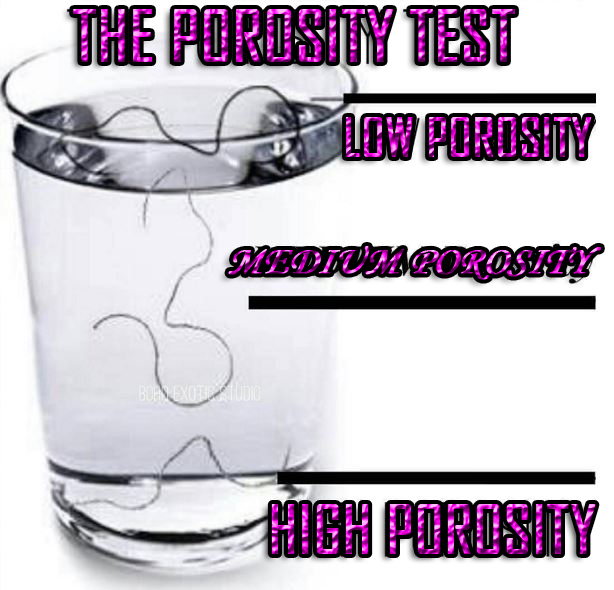
Know your porosity
Have you ever watched a hair commercial or video, with someone advertising a product, that seem to have a similar hair type or curl pattern as yours. But when you tried the products your results were not the same? Well it could be the person using that product has a different hair porosity than yours, making the end result quite different. What is hair porosity? Hair porosity is your hair’s ability to absorb water or moisture. There are three levels of hair porosity: Low, Normal/Medium and High. Each level determines how much water is absorbed in the hair.
Quick test to determine your hair’s porosity: take a few strands of your clean hair, and place in a glass of room temperature water. After a few moments the hair will stay afloat, sink to the middle, or sink to the bottom of the glass. If the strands stay afloat, you have low porosity hair, if the strands sink to the middle, you have normal/medium porosity, and if the strands sink to the bottom, you have high porosity hair.

Low Porosity: When the hair cuticles are tightly closed and resistant to opening, making it hard for moisture to penetrate the hair. Low porosity hair may often feel dry, due to lack of moisture penetration, and some products may feel coating verses moisturizing due to closed cuticles. Once you are able to get cuticles open, low porosity hair is able to retain a ton of moisture. Using hair steamers, deep treatments with hooded dryer, plastic caps wrapped in a turbie or towel will help open cuticles. You may also try placing your conditioners, or leave in conditioner bottles, in a warm glass of water to warm them prior to applying to hair. By using products with more alkaline ingredients (with higher ph levels), will help lift hair cuticle, allowing moisture to penetrate. Light penetrating oils and butters are best, when sealing, and limit your protein use for low porosity hair. *Some alkaline ingredients are: honey, almonds, orange, grapefruit, turmeric, carrots, kale, broccoli, glycerin, rosehip, moringa, spinach leaf, lemons, apricots, coconut water, and a ton of others.(humectants such as honey and glycerin help draw moisture to hair, are great for low porosity)
High Porosity: When the hair cuticles are not tightly closed, but open, making absorbing water not a problem, but retaining the moisture the issue. High porosity hair cuticles have been exposed to some level of damage, whether it’s over chemical processed, over manipulated or over usage of heat. Highly porous hair can also be genetic. Gaps or holes in the cuticle makes it easy for water or moisture to enter, but you must now focus on closing the cuticle to trap the moisture in. It is not necessary for steamers or hooded dryers due to already open cuticles, so focus on products with more acidic ingredients (with lower ph levels) that will help close the cuticle. Heavier penetrating butters and oils help seal in moisture, as well as products with proteins, or protein treatments are great for filling in the gaps. *Some acidic ingredients are: aloe vera, apple cider vinegar, avocado oil, olive oil, hempseed oil, watermelon seed, papaya leaf, hibiscus flower, coconut milk, castor oil, safflower oil, and juniper berries to name a few.
Medium/Normal Porosity: When the hair cuticle is open enough to receive moisture, and closed enough to retain moisture. Regular deep conditioning and use of healthy ingredient filled products are beneficial to medium/normal porosity hair.
*Note: No claims are made regarding the therapeutic use of this product... Plus, These statements have not been evaluated by the Food & Drug Administration.
These products are not intended to diagnose, treat, cure or prevent any disease.